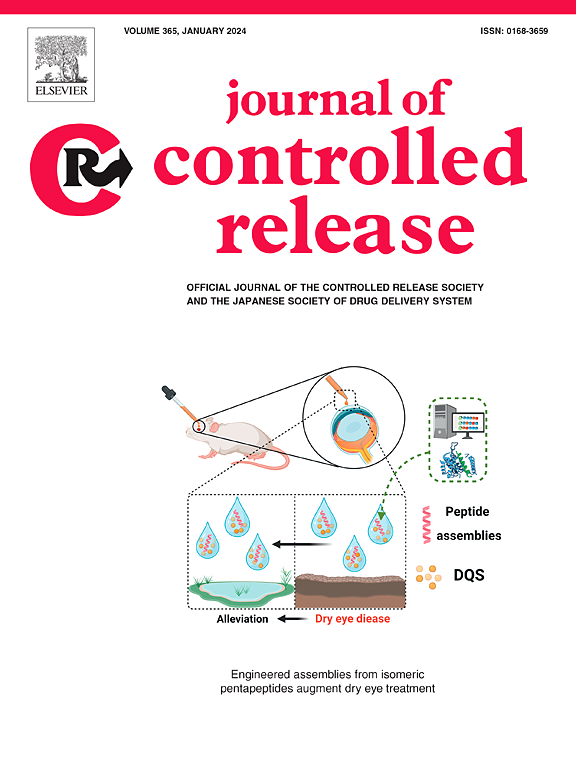Sonopermeation combined with stroma normalization enables complete cure using nano-immunotherapy in murine breast tumors
IF 10.5
1区 医学
Q1 CHEMISTRY, MULTIDISCIPLINARY
引用次数: 0
Abstract
Nano-immunotherapy shows great promise in improving patient outcomes, as seen in advanced triple-negative breast cancer, but it does not cure the disease, with median survival under two years. Therefore, understanding resistance mechanisms and developing strategies to enhance its effectiveness in breast cancer is crucial. A key resistance mechanism is the pronounced desmoplasia in the tumor microenvironment, which leads to dysfunction of tumor blood vessels and thus, to hypoperfusion, limited drug delivery and hypoxia. Ultrasound sonopermeation and agents that normalize the tumor stroma have been employed separately to restore vascular abnormalities in tumors with some success. Here, we performed in vivo studies in two murine, orthotopic breast tumor models to explore if combination of ultrasound sonopermeation with a stroma normalization drug can synergistically improve tumor perfusion and enhance the efficacy of nano-immunotherapy. We found that the proposed combinatorial treatment can drastically reduce primary tumor growth and in many cases tumors were no longer measurable. Overall survival studies showed that all mice that received the combination treatment survived and rechallenge experiments revealed that the survivors obtained immunological memory. Employing ultrasound elastography and contrast enhanced ultrasound along with proteomics analysis, flow cytometry and immunofluorescene staining, we found the combinatorial treatment reduced tumor stiffness to normal levels, restoring tumor perfusion and oxygenation. Furthermore, it increased infiltration and activity of immune cells and altered the levels of immunosupportive chemokines. Finally, using machine learning analysis, we identified that tumor stiffness, CD8+ T cells and M2-type macrophages were strong predictors of treatment response.


超声渗透与基质正常化相结合,利用纳米免疫疗法彻底治愈小鼠乳腺肿瘤
纳米免疫疗法在改善晚期三阴性乳腺癌患者预后方面大有可为,但它并不能治愈疾病,中位生存期不到两年。因此,了解乳腺癌的耐药机制并制定提高疗效的策略至关重要。一个关键的耐药机制是肿瘤微环境中明显的脱钙现象,这会导致肿瘤血管功能失调,从而造成灌注不足、给药受限和缺氧。人们曾分别采用超声波渗透和使肿瘤基质正常化的药物来恢复肿瘤血管异常,并取得了一些成功。在这里,我们在两个小鼠正位乳腺肿瘤模型中进行了体内研究,以探索超声波渗透与基质正常化药物的结合是否能协同改善肿瘤灌注并提高纳米免疫疗法的疗效。我们发现,拟议中的组合疗法可大幅减少原发性肿瘤的生长,在许多情况下肿瘤已无法测量。总体存活率研究表明,所有接受过组合疗法的小鼠都存活了下来,再挑战实验表明,存活下来的小鼠获得了免疫记忆。通过超声弹性成像和对比增强超声以及蛋白质组学分析、流式细胞术和免疫荧光染色,我们发现组合疗法可将肿瘤硬度降至正常水平,恢复肿瘤灌注和氧合。此外,它还增加了免疫细胞的浸润和活性,改变了免疫抑制趋化因子的水平。最后,通过机器学习分析,我们发现肿瘤硬度、CD8+ T 细胞和 M2 型巨噬细胞是治疗反应的有力预测因素。
本文章由计算机程序翻译,如有差异,请以英文原文为准。
求助全文
约1分钟内获得全文
求助全文
来源期刊

Journal of Controlled Release
医学-化学综合
CiteScore
18.50
自引率
5.60%
发文量
700
审稿时长
39 days
期刊介绍:
The Journal of Controlled Release (JCR) proudly serves as the Official Journal of the Controlled Release Society and the Japan Society of Drug Delivery System.
Dedicated to the broad field of delivery science and technology, JCR publishes high-quality research articles covering drug delivery systems and all facets of formulations. This includes the physicochemical and biological properties of drugs, design and characterization of dosage forms, release mechanisms, in vivo testing, and formulation research and development across pharmaceutical, diagnostic, agricultural, environmental, cosmetic, and food industries.
Priority is given to manuscripts that contribute to the fundamental understanding of principles or demonstrate the advantages of novel technologies in terms of safety and efficacy over current clinical standards. JCR strives to be a leading platform for advancements in delivery science and technology.
 求助内容:
求助内容: 应助结果提醒方式:
应助结果提醒方式:


